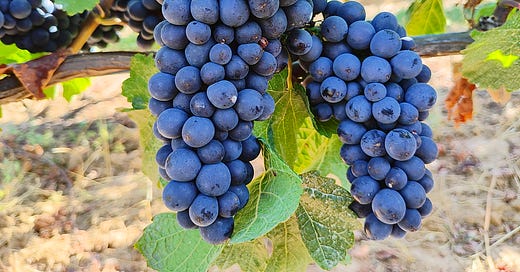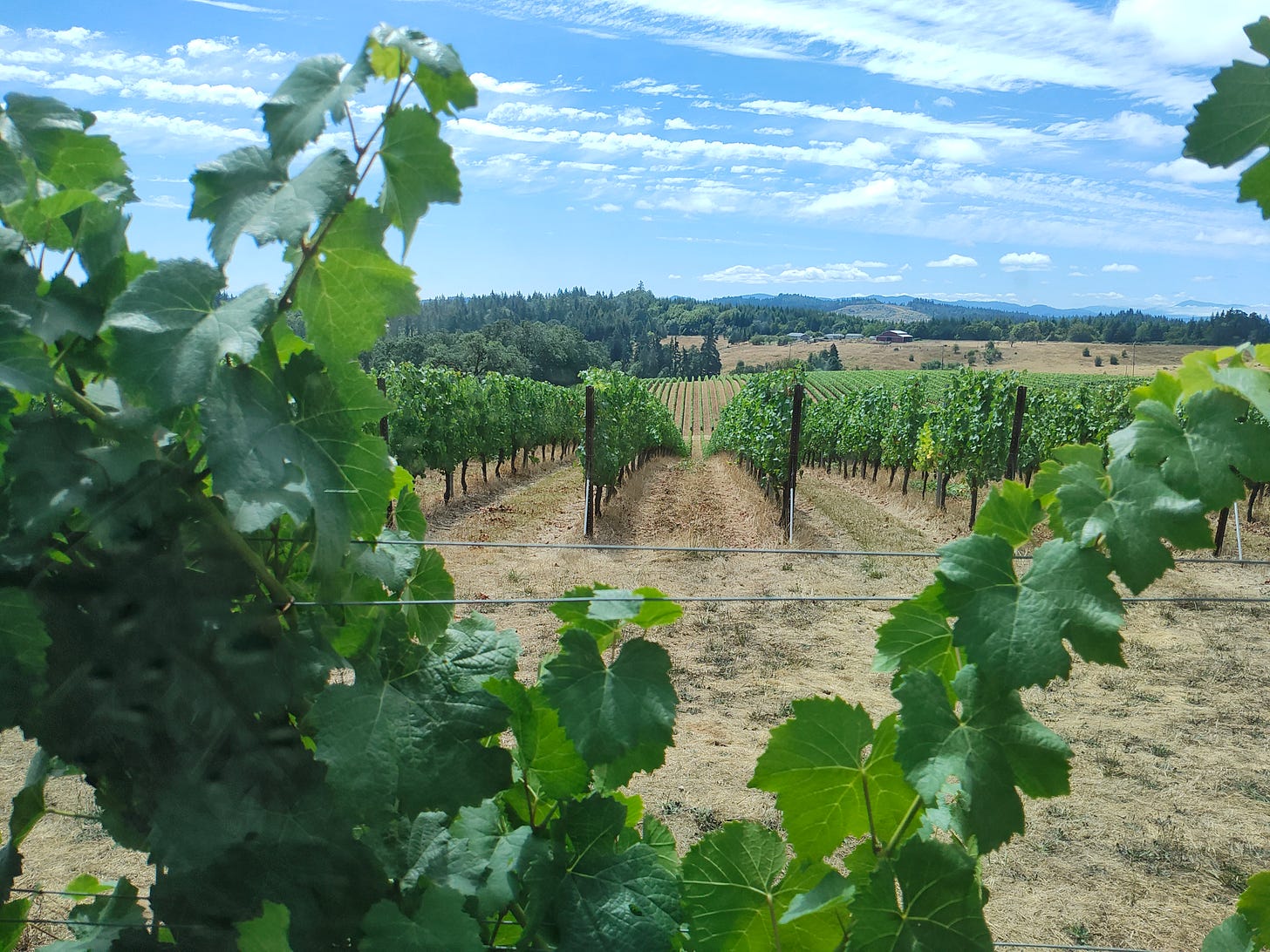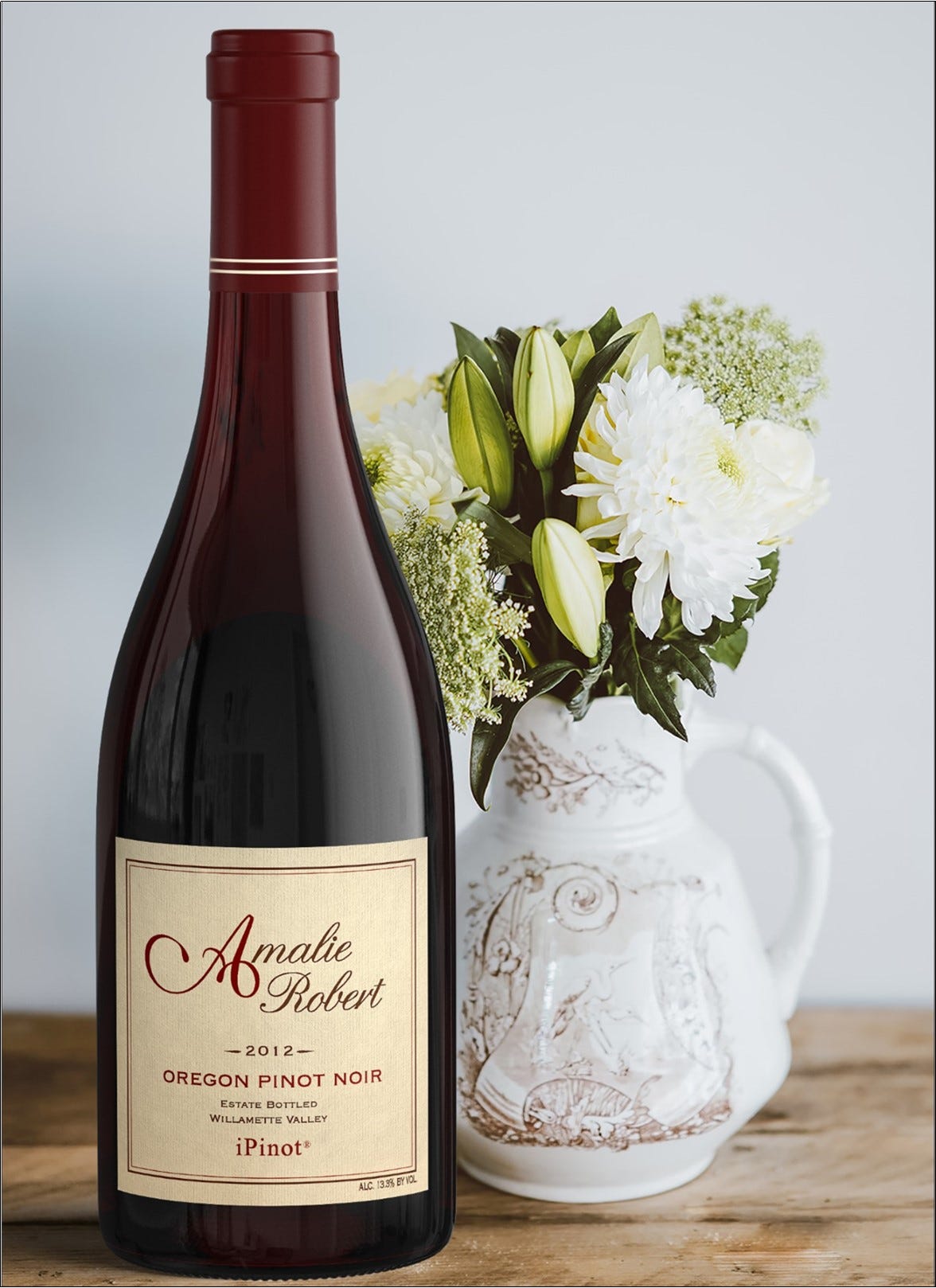Amalie Robert Estate Climate Update: August 2024
Hello and Welcome,
August marks the beginning of the end, or the end of the beginning, for Willamette Valley Pinot Noir, depending on how you look at The Great Custer Puck.
In This Communication:
The Big Picture
Winemaking: The Continuation of Terroir by Other Means.®
The Main Story: So, Whose Job Is It?
What Does This Mean and Why Should I Care?
The Numbers
Fire Watch: The Pacific Northwest
Other Resources
The Big Picture
Typically, the winegrower sees The Great Cluster Pluck as the end of a long, arduous summer punctuated with unfortunate, but not uncommon agrarian events. We could belabor these points, in excruciating detail, (with receipts), but it would just be too painful to do so.
The winemaker sees a fresh beginning with a new vintage. How very exciting for you! While the winemaker may have been involved in some vineyard decisions along the way, they take responsibility for the vintage when they accept the grapes, usually. Vintage 2020 smoke taint drove that point home.
Both the winegrower and winemaker have an opinion on when to harvest. And when those opinions align, The Great Cluster Pluck ensues forthwith. How those opinions come to align is a completely separate matter. Often times rated M for Mature audiences only.
iPinot® Pinot Noir 6-Pack Digital Offer
iPinot® Pinot Noir - a reserve level wine without the reserve level price. iPinot® Pinot Noir is created from reserve quality barrels of wine selected for our “Hers and His Reserves” - Amalie’s Cuvée and Estate Selection Pinot Noirs. Once the final “Hers and His Reserve” wines are blended, we have a few reserve level barrels of wine left to blend. We blend these cellar worthy barrels of wine together to create iPinot® Pinot Noir - a reserve level wine without the reserve level price.
Experience cellar worthy, Willamette Valley iPinot® Pinot Noir by Amalie Robert Estate. We are offering select vintages of iPinot® Pinot Noir for our 6-Pack Digital Offer!
Winemaking: The Continuation of Terroir by Other Means.®
We are living the dream so you don’t have to. Winemaking: The Continuation of Terroir by Other Means.® is a repository of our farming history at Amalie Robert Estate.
We have over 200 posts going back some 20 years. It’s all out there on Substack. You can visit the archive for FREE! If you want to see what we see on a more regular basis, follow us on Instagram @AmalieRobert.
Planning to enjoy traveling again and exploring the Willamette Valley? There are two primary gateways to the Willamette Valley. Most people are familiar with Portland International airport (PDX) at the top of the Willamette Valley. However, there is a second gateway in Eugene (EUG) at the south end of the Willamette Valley. Both of these airports service the major carriers.
Insider Tip: Alaska Airlines offers a Wine Flies Free program from both PDX and EUG. You will need to acquire a wine shipper box as you tour the valley. When you check in for your flight, indicate you have a case of wine, and it will be checked for FREE on Alaska Airlines. BONUS: Many wineries will provide you a FREE wine shipper box with a 6 bottle purchase.
Interested in learning about the newest AVA? Download our FREE guide to the Willamette Valley AVA’s!
Amalie Robert Estate is open year round by appointment for vineyard tours and tastings. Request a tasting appointment with your preferred day and time.
If your plans have you somewhere other than the Willamette Valley, the Big Blue Button can co-locate your wines with YOU!
We suggest a UPS or FedEx drop point to allow you to pick up your wine at your leisure. It's better on the A-List. A-List members receive a 10% discount on any 1-11 bottle purchase, a 20% discount on a 12-bottle case purchase, and domestic ground shipping is always included with a case. Please email Dena for shipping options to Alaska and Hawaii.
The Main Story: So, Whose Job Is It?
Wine, whether it contains alcohol or not, is supposed to provide pleasure. That responsibility lies with the winery in creating a pleasurable product (production) AND convincing you that the product is pleasurable (marketing) AND providing a pathway for you (sales) to enjoy the pleasurable experience that wine is uniquely positioned to provide.
Whew, that’s a lot on one plate. So, let’s break it down.
Wine is fermented from an annual agricultural product called grapes, aka wine berries. Winegrowers get one shot a year to get it right. But what is right? Certainly, we don’t want to see rot, that makes flawed wine. Ideally, we want the aroma, flavor and texture of the wine to represent the characteristics of the vintage from which it was produced. AND to taste good, that’s nice.
Wine quality often derives from the good judgement and decisions the winegrower implements in a timely manner. As most people over the age of 50 will tell you, good judgment is a product of poor judgement and lack of experience (which is something you get when you don’t get what you want). All successful winegrowers have good judgement derived from a wealth of experience.
An Estate grown winery begins with the most important decision of all, the soil and where to grow vines. Then it is the clones and rootstocks, vine spacing and trellis design. Next comes the development phase of implementing the physical representation of the mental construct. Pounding posts and running wire (in the rain) is no picnic, we can tell you that. Whew, OK now you have a vineyard.
During the growing season the winegrower is managing cover crops or permanent grass, hand labor or machine for managing the canopy, and mowing the grass. Leaf pull is a master class in and of itself as it very much determines how a wine feels in your mouth.
And then there is the agricultural machinery, such that it is. The winegrower keeps that equipment running or finds a way to get it done while the machine is under repair. Clearly, farming embraces new technology as best as it can, but that is not saying a whole hell of a lot.
As the vintage proceeds unabated, the wine berries are sweet with sugar and their acids are dropping. The weather is cool and daylight hours are shrinking. Acknowledging the fact (and reviewing historical records), that it is going to rain, the winegrower and winemaker get together to discuss The Great Cluster Pluck.
The winemaker knows they must deliver a pleasurable wine that is economically viable (that sales can sell it at a profit) from what the winegrower has labored to produce. The decision is at first technical, what are the sugar and acid concentrations? Right, so the winegrower methodically snips some clusters and provides them for analysis. Sampling continues (in an agreeable manner) for a little while.
The rules of the road are typically observed as follows: Sugar concentrations measured in Brix range from a low of 20 to a high of 24. This gives an alcohol potential in the range of 12.0% to 14.4%. Brix much higher than 26 will cause the yeast to die before fermentation is complete, resulting in a sweet wine. Thus, this provides an upper limit as the wine berries continue to build sugar concentrations.
pH is the other useful measure, but even more useful if measured over time. pH measures acid concentration in the wine berries. The longer they are on the vine, the less acid they have causing the pH to rise. If you don’t have a chemistry background but understand finance, just remember when bond prices fall, yields rise.
As the wine berries ripen, the natural progression is for sugars to accumulate and acids to deplete. This means Brix goes up and pH goes up. If we see Brix go up (more sugar concentration) AND pH go down (more acid concentration) this means the wine berry is losing water, thus concentrating both sugar and acid. This is not a sign of ripening, but desiccation, and a common situation in hot, dry years.
The last part of the harvest decision matrix is sensory. Specifically, a few clusters are put into a mesh bag and squeezed, not very gently. As the bag is emptied of skins and seeds, particular attention is paid to the seed color. The resulting juice is captured in a bucket and then put into sample bottles and allowed to settle overnight. The next day, the winemaker evaluates color, aroma, and flavor of the settled juice.
The more brownish (martini olive) and less green the seeds, the more ripe the wine berry. Because, the vine is trying to reproduce by ripening viable seeds that will pass through an animal, all wrapped in a very aromatic and sweet wine berry. Everything we are doing is simply monitoring this process until the wine berry fits our winemaking needs.
It is going to rain. Yes, but not yet. Right, but soon. I am not seeing that. Can you bring another set of samples next week? And so goes the dialog between the winegrower to the winemaker. The winemaker knows the more hangtime, up to a point, the more aromatic and flavorful the wine. The winegrower knows that if left out on the vine too long, they will rot, and then all of that fun over the summer months will have been for naught. They both want the same thing, but sometimes have a hard time getting to yes.
And then it does rain, maybe just a bit, maybe a bit more. Then it begins to get real. Harvest crews are getting scheduled, and harvest tote bins and buckets are at the ready. The winery is ready to receive, and the winemaker takes center stage. The winegrower now must execute on that schedule.
What Does This Mean and Why Should I Care?
The winemaker bears ultimate responsibility for the style of wine produced. Every winemaker has thoughts on what a wine should be, the pleasure potential if you will. As the wine drinker, your role is to align yourself with winemakers who share your interpretation of what a wine should be. This will maximize your pleasure potential.
The winemaker can influence the winegrower during the growing season, but the ultimate responsibility for what is poured in your glass resides solely with the winemaker.
Pluck early for lower alcohol potential or wait for more concentration? Ferment with whole clusters? Add yeast or wait for the fermentation to kick off spontaneously? These are all decisions that will impart character in your wine. The use of new oak barrels certainly makes an impact, but often at the cost of masking a vineyard site’s inherent beauty and terroir. Some barrels of wine stand alone, others are good blending components. It is in the final blending that the hand of the winemaker is revealed.
Fortunately for us, we have a full-length mirror that Ernie can stand in front of. He will carry on for some time. Unfortunately, the mirror is wide enough that he can see both his hands. Hence on the one hand he is the winegrower, but on the other hand he is part of the winemaking team. That’s when Dena who is the other half of the winemaking team steps in front of the mirror with Ernie.
Dena takes the lead in the final stage of the process and that is sales. While Ernie has some pretty interesting (aka that’s never gonna happen) ideas, Dena helps bring those ideas into focus and potentially, fruition. While some experimentation is certainly in everyone’s best interest, as in block 13 Syrah, Dena provides a moderating influence (aka I can’t sell that).
The rest is an exercise left to the reader. Or more specifically, the wine drinker.
The Numbers
We recorded 528.7 Degree Days for the month of August, the high temperature for the month was 99.7 degrees recorded on August 1st at 4:12 pm, and the low temperature was 44.2 degrees recorded om August 28th at 3:24 am. This brings the 2024 growing season total to date 1,926.5 Degree Days.
There was no measurable precipitation in August. Total rainfall for the 2024 growing season now stands at 5.86 inches.
Kindest Regards,
Dena & Ernie
Other Resources
Visit our Website
Visit the FLOG Archive
Take the Amalie Robert Tour
Shop Amalie Robert Direct
Download your FREE Willamette Valley sub-AVA Guide
Alaska Airlines Wines Fly Free













